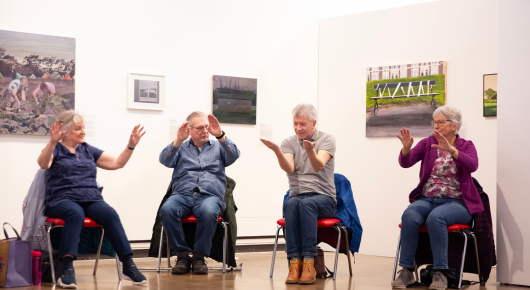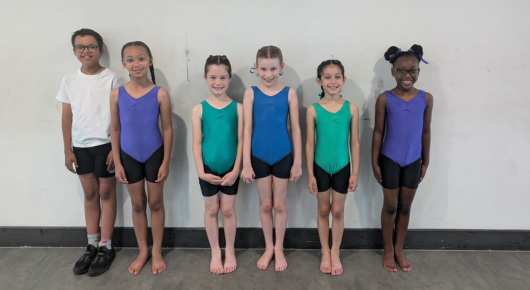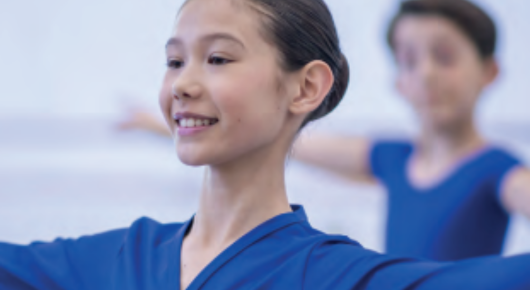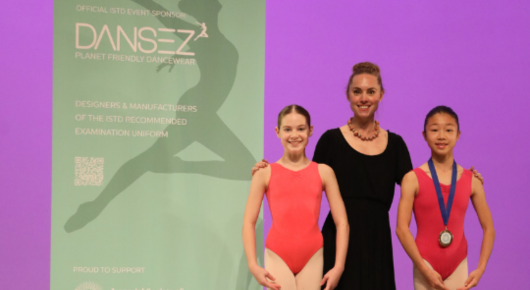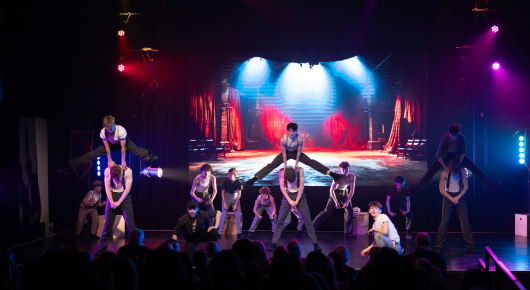12 November 2025
Mark is the Founder and Artistic Director of Deaf Men Dancing, a groundbreaking company. He trained at the Royal Ballet School and London Studio Centre and has choreographed for major productions including The Little Big Things, Hedwig & The Angry Inch, The Hunchback of Notre Dame in Concert, and The Who’s Tommy. His work has earned him multiple award nominations, including an Olivier Award nomination for Best Theatre Choreographer in 2024. His work continues to break boundaries and open doors for D'deaf and Disabled artists in dance. We are also proud to have him as an ISTD patron.
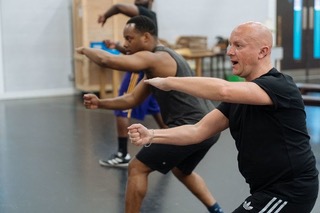
Photo: Manuel Harlen. Rehearsal for The Color Purple at Curve Theatre, Leicester
Access Becomes Art
When asked what this year’s theme for World Ballet Day means to him, Mark reflected on how access allows equality and visibility within the industry:
“When we have access, especially with interpreters and notetakers, it helps us to be part of the mainstream. It means we can work smoothly, without stress, and focus on the art, I think it’s important to be equal. It’s changing a lot now, which is great. Access support helped me to work in the mainstream theatre. People are becoming more open-minded.”
For Mark, the progress happening in recent years is something to celebrate. The shift toward inclusion is opening up new opportunities for D'deaf and Disabled dancers to create and perform.
Synergy: Connection and Community
Mark spoke to us about leading Synergy, a powerful dance project that explores how Climate change can affected D'deaf and Disabled people or communities, especially their health and mental health. Inspired by astrology, the Big Bang, and the climate crisis.
Performed at major venues including Birmingham Hippodrome and GDIF’s Dancing City, Synergy later evolved into Synergy 2.0 through a cross-cultural collaboration with disabled dancers in South Africa. The project has been supported by leading organisations such as Without Walls, Arts Council England, and Sibikwa Arts Centre.
“The word Synergy really drew me in. It represents people coming together, creating a sense of community. It’s about empowerment. During the pandemic, it was especially hard for me as a Deaf person. With everyone wearing masks, communication was very difficult. I felt very isolated.” Mark described how he wanted the piece to be truthful about those experiences while also highlighting unity and hope.

Photo: Sniped by Kim
“I wanted to create a piece that reflects what we’ve been through, the experience of people wearing masks during the pandemic, making lipreading impossible and leaving many feeling isolated and cut off. My aim was to shine a light on that lack of access and support, but also to celebrate how disabled people can come together so we don’t feel alone.
The message is about collective power: when we unite, we create energy, energy that keeps life going, just like machines need power to function. The climate crisis has drained the planet’s energy, and the only way to renew it is through community. By standing together and fighting for Access, Equality, and Human Rights, we create synergy. That’s what this piece is about
Each dancer’s story in Synergy came from real experiences - from communication barriers to mental health and the struggle for access.
Barriers and Change in the Industry
Mark has seen real change since he began dancing, though many challenges remain.
“Ten or twenty years ago, I was afraid to say I need interpreters, or I need the room not to be too acoustic because I can’t concentrate and struggle to hear music clearly and can't hear people's voices. I didn’t want to be a burden or think I might not get employed.” He believes that more awareness and education are key to moving forward, people need to take part in Deaf Awareness Courses where they will learn basic BSL and learn the Do & Don't when working with D'deaf people, so dancers of this generation and future don’t have those worries. It’s more about the lack of knowledge. People need to learn more about disabilities."
Access to Work and Support
Mark also spoke about the importance of Access to Work (ATW), a government scheme that provides support like support workers and interpreters.
“Dancers who need it really should apply. It’s from the government and It’s designed to remove barriers to employment so people with disabilities can fully participate in work. Personally, it helps me be able to work smoothly, without dealing with the stress and communication breakdown, it really helps a lot. ATW made my life easier. I wish I had ATW 10 years ago.”
Advice for Young Dancers
Mark’s advice for young dancers with disabilities is full of encouragement:
“Go for it and believe in yourself. Don’t be scared. Enjoy it, embrace it, and be a sponge - I always say be a sponge, learn everything!”
Reflecting on his own training, he said:
“When I was training at London Studio Centre it was brilliant. - three years of learning that I absolutely loved. I absorbed everything like a sponge, from Spanish dance to commercial styles. As a disabled dancer, you’ll work twice as hard as your non-disabled peers, but that effort builds resilience, determination, and longevity in your career. Stay committed, work hard, and always treat people with respect. Your reputation matters, the dance and theatre industry is a small world.
He encourages young dancers to stay curious and look beyond boundaries:
“Open your horizon, research, learn all the choreographers names and study their work, build contacts in your industry and try to see as many shows as you can - dance shows, musical films, musical theatre, everything. Watch your industry. Look at YouTube, look at clips of Gene Kelly, Janet Jackson, Bob Fosse, Matthew Bourne. learn from them all.”

Photo: Paul Nicolas Dyke - PND Photography
Mark’s story shows exactly what World Ballet Day 2025 is celebrating - that when access and inclusion are treated as integral to creativity, art itself becomes stronger. Through his work, his leadership, and his voice, Mark continues to prove that when everyone has the tools and support to participate equally, access truly does become art.

